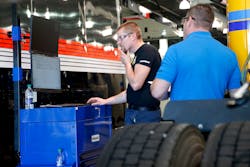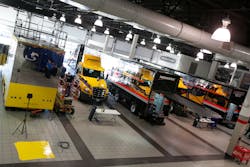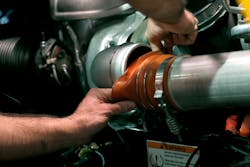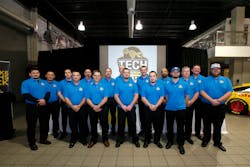How Penske has revamped its technician program to target training and measure success
When Holly Gerke set out to refresh the technician training program for transportation service provider Penske Truck Leasing, she understood that it would be a daunting process.
Gerke, the director of technical training, along with Mike Hasinec, vice president of maintenance, first worked with a pilot location to focus on a few key areas. The training program has grown from there, with a dedicated training team that helps evaluate and improve certain vehicle service processes and pain points across the transportation service provider’s 765 locations.
In order to measure the progress of this training program and confirm these processes stuck, Penske recently reintroduced its internal technician skills competition, Tech Showdown. This marks the first year the organization has allowed the dedicated training team to take on the competition.
Overview of the training organization
Seven years ago, Gerke established a plan to formally introduce a corporate-wide training program. That training team implemented a pilot program with a Charlotte, North Carolina, location to determine the pain points and necessary training needed to establish a baseline for training initiatives.
“It was pretty overwhelming in the beginning because there were so many things that we needed to educate and train people [on],” Gerke says, explaining that they started by pinpointing a short list of behaviors they were looking to change and built the program from there.
Since that time, Gerke has built a corporate team of more than 40 Penske personnel dedicated to communicating with field locations about training needs, coordinating onsite and remote training, delivering instructor-led experiences, creating training content, and more.
Part of this training involves partnerships and working relationships with truck original equipment (OE) manufacturers to ensure essential and proper training for each vehicle make. This mutually beneficial relationship has also provided OEs first-hand feedback on vehicle challenges with training and service improvements.
When it comes to the skills competition, Gerke says the training team made sure to confirm with the OEs that service processes were being completed accurately.
“We verify what it is that we're using in terms of tools, procedures, anything that we would want to be included in the [technician skills] challenge ... we have reviewed all of that material with OEs,” Gerke says.
How the technicians will consume the training materials has been considered in the development of the training curriculum as well.
“Our strategy is really around understanding that adults can consume information in bite-sized chunks and be able to apply that much more successfully than trying to learn everything and trying to apply everything at one time,” Gerke explains.
These training materials are another important aspect of what the Penske corporate training team provides to technicians. With a fleet of more than 326,000 vehicles and 8,600 technicians across North America, there is a vast need for learning materials and a number of different ways that personnel learn best. Hands-on and on-location training are certainly a big part of the training process for the organization, but remote training is also made available through in-house content such as the internally created HOW2 video series. The training team can create new videos and adapt existing ones quickly and distribute those materials accordingly.
As technicians participate in training, the Penske training team works to ensure the trained personnel are able to put their recently learned skills into real-world applications.
“One of the things that we've been heavily focused on working with field management teams is to get them to actually put technicians on these jobs after they come out of class,” Gerke says.
Another key way that the training team can now validate training initiatives? A competition.
Overview of the skills competition
A technician skills competition is designed to test the best of the best for an organization or industry.
In addition to the more comprehensive and corporately directed training program, the Penske training team took the lead in organizing the refreshed skills competition known as the Tech Showdown.
Penske held its Tech Showdown 2019 technician skills competition at the Team Penske headquarters December 18, in Mooresville, North Carolina.
Already attending the national competition deserves notable recognition. The competition featured 16 national finalists, trimmed down from the initial 1,299 technicians who signed up at the district level. This required advancing through four rounds of competition, beginning at the most local district level, followed by area level, and finally the national level.
The finalists came from across North America, including two from Canadian provinces, a competitor from Hawaii, and numerous technicians from throughout the continental U.S.
Technicians interested in participating at the district level began testing in September of 2019. Through the fall, the competition included vetting technicians through hands-on and written testing. This testing process can become quite involved, which was one of the challenges with the previous method for holding the competition - separate districts were responsible for holding their own competitions, which meant much more work and oversight required by each location, and less overall consistency for testing.
“The hands-on piece you could imagine takes a lot of pre-work - set up the vehicle, bug the truck, different things like that,” Hasinec explains.
Now, with the corporate training team in place, they are able to oversee and manage the entire process from start to finish.
With the new competition structure, the organization looked to focus on two key training areas: preventive maintenance (PM) and exhaust stream management.
The PM testing was held during the early rounds of the competition, through written testing.
The national competition included a hands-on exhaust stream management diagnostic test on a Freightliner Cascadia with a Detroit Diesel engine.
The Penske fleet operates and services all makes and models. During the entire competition, a technician will not know ahead of time which vehicle make, chassis, and engine they may be tested on.
“We share and expose them to whatever we can,” Hasinec says. “But we do look at the more predominant models and components that are in our fleet because when you're as big as we are, there are some that you have more of than others.”
For the hands-on portion this year’s inaugural revamped competition, the exhaust stream management focus was selected based on an assessment of the current service pain points throughout the organization, Hasinec says. Exhaust stream management refers to the engine aftertreatment system.
“We’ve worked the last few years really to bring everyone around on understanding the complexity and how that whole system interacts with upstream and downstream and all the components involved, what the truck is trying to tell you, and [to] look internally first,” Gerke adds.
Competition judges Ernie Luzania and Derek Walker, who both also work on the Penske training team, shared insights on the troubleshooting process and evaluating participants for the hands-on portion at this year’s Tech Showdown. Both moved up the ranks after starting off as technicians.
Luzania is the manager of technical training and runs the team of 37 trainers who provide training to all Penske locations. Walker, a technical development specialist, is one of the three repair and diagnostic trainers on the training team.
Participants are evaluated based on the speed and thoroughness of their troubleshooting and assessment, judged on a points system. They have one hour for the hands-on portion. No technicians in this year’s competition actually solved the issue, but those who scored highest were able to display the steps in the diagnostic process most accurately and comprehensively.
The troubleshooting process involves understanding what’s happening upstream or downstream from the actual aftertreatment system, which requires electrical training knowledge as well.
“In the real world, it could be one hour or 10 hours [to diagnose a vehicle issue],” Luzania says. “Our goal is … if it takes 10 hours, we just don't want it coming back. Anything that goes back out to the customer and doesn't get returned is a win for that shop, the customer, and everybody else.”
Penske does not measure completed service work on standard repair times (SRTs), which Luzania says are designed for dealership service. Instead, Penske provides “goal times” to technicians, known as established repair times (ERTs). ERTs are updated quarterly in the Penske system, calculated by averaging the data from all the repairs throughout the organization’s network.
The ERTs are periodically adjusted and will update according to the updated times it takes to complete work. For new jobs not yet in the system, such as a soot sensor replacement, the system relies on SRT information from the manufacturer until there is more real-world shop service recorded. Plus, over time with technology changes, a job may become faster or increasingly complicated, Luzania notes.
“I'd say the big one for us ... through feedback from technicians is transmission and clutch repairs,” says Derek Walker, technical development specialist, on jobs that have reduced ERTs over time. “Since we've gone to four-post lifts, a lot of guys are saving a lot of time. Compared to a shop with a pit jack ... just picking up [the vehicle] overhead” has lowered the ERT for that service.
Conversely, a seemingly simple water pump replacement has changed considerably.
“A water pump before could take a long time, but it was low technology,” Luzania says. “Nowadays a water pump is right in front. It could take five minutes [to replace the part], but if you don’t refill it properly with the right equipment you could ruin a lot of things along the way … the repair itself may not take too long, but all the ancillary things have now become critical.”
When it comes to the competition, a diagnostic process can put added pressure on the technician. Luzania says he and his fellow judges try to keep the testing portion relaxed.
“Everybody reacts to pressure differently,” he says. “Some guys lock up, some get clammy. We just try to calm everybody and say, ‘Just behave how you would in a shop. Let's just watch you.’ These guys have an incredible task.”
Overall, the idea behind the training and development of technicians is to have the process become second nature, regardless of the setting.
“We want to develop good muscle memory,” Luzania says of technician training. “So if they have noise in the shop or when someone is coaching them with a bad habit, hopefully, their muscle memory takes over and they use good habits and good, known testing procedures, and they literally can find themselves [from the beginning to the] actual problem.”
As far as the outcome for the Tech Showdown, the top five finishers received additional recognition for their overall performance in the national competition. David Sledziewski, a technician from the Wilkes-Barre, Pennsylvania, location took top honors.
Sledziewski was enthusiastic, but surprised, about winning the competition.
“I’m shocked,” he says. “I tried as hard as I could. I didn’t feel as though I finished the troubleshooting, but apparently, no one did. Apparently, I was on the right track.”
Sledziewski has been a technician since 1981. In his 39 years of turning wrenches, he says he’s found the diagnostic process to be the most satisfying and challenging. “I really like electrical work [and] module communication with the trucks now. I knew if I was going to stay in this business, I had to keep up with it and keep advancing and learning everything new that came out.”
All of the competitors who talked to Fleet Maintenance stressed the importance of taking any training made available through Penske for continued success in their fields.
The day of the competition, Penske Truck Leasing president Art Vallely announced the monetary values for the top three finishers would be doubled to $10,000; $7,000; and $4,000, respectively. Additionally, he added a $1,000 prize for the fourth and fifth place finishers. All five top finishers will also receive signed racing helmets from the Team Penske racing teams, to be signed once the drivers return for the 2020 racing season.
The other top finishers were as follows: Stanley Lindler from Columbia, South Carolina; Brenden Waggy, from Dayton, Ohio; Dan Ferrer from North Liberty, Iowa; and Mark Parisotto, from Burnaby, British Columbia.
What the future holds
The competition, according to Hasinec, has two main objectives: to recognize and reward technicians for their comprehensive understanding of proper vehicle service, and to acknowledge and improve training where there is a lack of exceptional performance even for the top technician talent.
The competition provides insights on where improvements to training can be made. Case in point, if there are some core competencies that technicians are not meeting at that competition level, imagine the skillset of the average technicians who likely do not have that ability either.
“What we're trying to do with the showdown is foster this idea of learning,” Gerke says. “Part of that is definitely getting information not only back out to our technicians and their managers, but also the OEs to say, 'Hey these are the trends we see and here's what we learned going through this experience.'”
The training team looks to continue to assess areas of training that can be tested and plans to remain flexible for the hands-on portion of the skills competition. Preventive maintenance, as a core competency, will remain part of the competition, but exhaust stream management may not always be the other area of competition focus.
“Based upon needs and where the greatest area of opportunity we feel we have, we can change that from exhaust stream for the next couple of years to move to something like collision mitigation systems,” Hasinec says. “Anything new from a technology standpoint that we feel we need to focus on and put a very concentrated effort towards impacting costs as well as educating our technicians.”
About the Author
Erica Schueller
Media Relations Manager | Navistar
Erica Schueller is the Media Relations Manager for Navistar.
Before joining Navistar, Schueller served as Editorial Director of the Endeavor Commercial Vehicle Group. The commercial vehicle group includes the following brands: American Trucker, Bulk Transporter, Fleet Maintenance, FleetOwner, Refrigerated Transporter, and Trailer/Body Builders brands.
An award-winning journalist, Schueller has reported and written about the vehicle maintenance and repair industry her entire career. She has received accolades for her reporting and editing in the commercial and automotive vehicle fields by the Truck Writers of North America (TWNA), the International Automotive Media Competition (IAMC), the Folio: Eddie & Ozzie Awards and the American Society of Business Publication Editors (ASBPE) Azbee Awards.
Schueller has received recognition among her publishing industry peers as a recipient of the 2014 Folio Top Women in Media Rising Stars award, acknowledging her accomplishments of digital content management and assistance with improving the print and digital products in the Vehicle Repair Group. She was also named one Women in Trucking’s 2018 Top Women in Transportation to Watch.
She is an active member of a number of industry groups, including the American Trucking Associations' (ATA) Technology & Maintenance Council (TMC), the Auto Care Association's Young Auto Care Networking Group, GenNext, and Women in Trucking.
In December 2018, Schueller graduated at the top of her class from the Waukesha County Technical College's 10-week professional truck driving program, earning her Class A commercial driver's license (CDL).
She has worked in the vehicle repair and maintenance industry since 2008.




